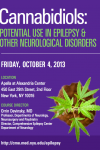“BACKGROUND
The Dravet syndrome is a complex childhood epilepsy disorder that is associated with drug-resistant seizures and a high mortality rate. We studied cannabidiol for the treatment of drug-resistant seizures in the Dravet syndrome.
METHODS
In this double-blind, placebo-controlled trial, we randomly assigned 120 children and young adults with the Dravet syndrome and drug-resistant seizures to receive either cannabidiol oral solution at a dose of 20 mg per kilogram of body weight per day or placebo, in addition to standard antiepileptic treatment. The primary end point was the change in convulsive-seizure frequency over a 14-week treatment period, as compared with a 4-week baseline period.
RESULTS
The median frequency of convulsive seizures per month decreased from 12.4 to 5.9 with cannabidiol, as compared with a decrease from 14.9 to 14.1 with placebo (adjusted median difference between the cannabidiol group and the placebo group in change in seizure frequency, −22.8 percentage points; 95% confidence interval [CI], −41.1 to −5.4; P=0.01). The percentage of patients who had at least a 50% reduction in convulsive-seizure frequency was 43% with cannabidiol and 27% with placebo (odds ratio, 2.00; 95% CI, 0.93 to 4.30; P=0.08). The patient’s overall condition improved by at least one category on the seven-category Caregiver Global Impression of Change scale in 62% of the cannabidiol group as compared with 34% of the placebo group (P=0.02). The frequency of total seizures of all types was significantly reduced with cannabidiol (P=0.03), but there was no significant reduction in nonconvulsive seizures. The percentage of patients who became seizure-free was 5% with cannabidiol and 0% with placebo (P=0.08). Adverse events that occurred more frequently in the cannabidiol group than in the placebo group included diarrhea, vomiting, fatigue, pyrexia, somnolence, and abnormal results on liver-function tests. There were more withdrawals from the trial in the cannabidiol group.
CONCLUSIONS
Among patients with the Dravet syndrome, cannabidiol resulted in a greater reduction in convulsive-seizure frequency than placebo and was associated with higher rates of adverse events. (Funded by GW Pharmaceuticals; ClinicalTrials.gov number, NCT02091375.)”
http://www.nejm.org/doi/10.1056/NEJMoa1611618
“Cannabinoids for Epilepsy — Real Data, at Last” http://www.nejm.org/doi/full/10.1056/NEJMe1702205
“Cannabidiol (CBD) Significantly Reduces Convulsive Seizure Frequency in Dravet Syndrome (DS): Results of a Multi-center, Randomized, Double-blind, Placebo-controlled Trial (GWPCARE1)” http://files.shareholder.com/downloads/AMDA-1TW341/201889199x0x919787/73B57FA6-CD45-4ABB-8C89-87EFEA36B4ED/1332B_AES_Poster_Dravet_Part_B_.pdf
“EPILEPSY AND MARIJUANA: CANNABIS DRUG REDUCES DRAVET SYNDROME SEIZURES IN LARGE-SCALE CLINICAL TRIAL” http://www.newsweek.com/cannabis-marijuana-dravet-syndrome-epilepsy-clinical-trial-614982
/cdn.vox-cdn.com/uploads/chorus_image/image/54932609/2928600995_24caa84411_o.0.0.jpg)







